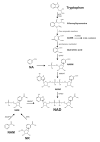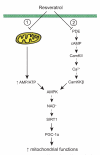NAD⁺ metabolism: a therapeutic target for age-related metabolic disease
- PMID: 23742622
- PMCID: PMC3858599
- DOI: 10.3109/10409238.2013.789479
NAD⁺ metabolism: a therapeutic target for age-related metabolic disease
Abstract
Nicotinamide adenine dinucleotide (NAD) is a central metabolic cofactor by virtue of its redox capacity, and as such regulates a wealth of metabolic transformations. However, the identification of the longevity protein silent regulator 2 (Sir2), the founding member of the sirtuin protein family, as being NAD⁺-dependent reignited interest in this metabolite. The sirtuins (SIRT1-7 in mammals) utilize NAD⁺ to deacetylate proteins in different subcellular compartments with a variety of functions, but with a strong convergence on optimizing mitochondrial function. Since cellular NAD⁺ levels are limiting for sirtuin activity, boosting its levels is a powerful means to activate sirtuins as a potential therapy for mitochondrial, often age-related, diseases. Indeed, supplying excess precursors, or blocking its utilization by poly(ADP-ribose) polymerase (PARP) enzymes or CD38/CD157, boosts NAD⁺ levels, activates sirtuins and promotes healthy aging. Here, we discuss the current state of knowledge of NAD⁺ metabolism, primarily in relation to sirtuin function. We highlight how NAD⁺ levels change in diverse physiological conditions, and how this can be employed as a pharmacological strategy.
Figures





References
-
- Audeh MW, Carmichael J, Penson RT, Friedlander M, Powell B, Bell-McGuinn KM, Scott C, Weitzel JN, Oaknin A, Loman N, et al. Oral poly(ADP-ribose) polymerase inhibitor olaparib in patients with BRCA1 or BRCA2 mutations and recurrent ovarian cancer: a proof-of-concept trial. Lancet. 2010;376:245–251. - PubMed
Publication types
MeSH terms
Substances
Grants and funding
LinkOut - more resources
Full Text Sources
Other Literature Sources
Medical
Research Materials
